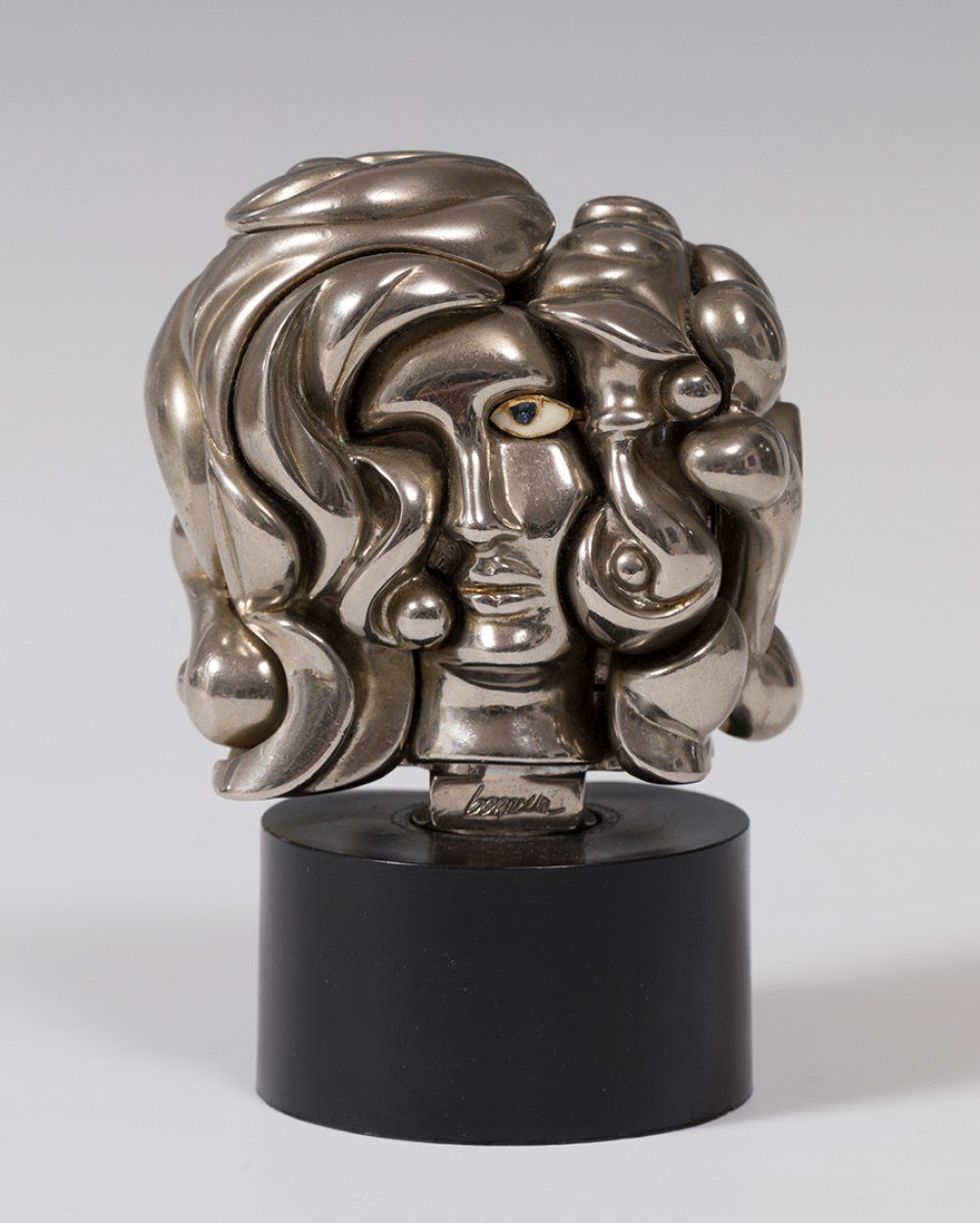Description
MIGUEL ORTIZ BERROCAL (Villanueva de Algaidas, Málaga, 1933 - Antequera, Málaga, 2006). "Portrait of Michèle". Brass. Item 7643. Consists of 17 assembled elements. Attached assembly book. Measurements: 10 x 7 x 5 cm; 3 x 5,5 cm (base). Miguel Ortiz Berrocal showed a special predilection for articulated and detachable sculptures. Inspired by the main creative forces of the first half of the 1900s, the artist sought his own artistic path. He drew his inspiration from science and created works based on mathematical, physical and scientific principles. He also developed the concept of "dismountability", understood as the process of searching for the inner forms of volumes, which implies that sculptures are composed of elements that have to be assembled and disassembled in order to penetrate their invisible space. Berrocal began his training at the Escuela de Artes y Oficios in Madrid, where he was a pupil of Ángel Ferrant. He then went on to the San Fernando School of Fine Arts, where he was a pupil of Ramón Stolz. He complemented his training with work as a draughtsman in the studio of the architect Casto Fernández Shaw and as an assistant to various architects in Rome between 1952 and 1954. During his stay in Paris in 1955, he finally decided to devote himself to sculpture. His first works show the influence of Chillida, while at the same time denoting his preference for articulated and detachable forms in bronze. The difficulty involved in making each of his sculptures led him to decide to produce them in series. With this idea in mind, he produced two hundred copies of the sculpture "Maria de la O", for which he received the prize for sculpture at the Paris Biennale and which was later acquired by the MOMA in New York. In 1966 he settled permanently in Verona, and from 1968 he alternated his work between monumental and small-scale works. Together with several gallery owners, he founded the Società Multicettera, the first industry of small sculptures. He has exhibited in Italy, France, Germany, Spain and the United States, received the gold medal of the Bronze of Padua, the Grand Prize of Honour at the Brazil Biennial, and was named Knight of the Order of Arts and Letters by the French government. He has sculptures in public places in Korea, Bordeaux, Denmark and Switzerland, as well as in various places in Spain. He is represented in the Museums of Modern Art in New York and Paris, the Olympic Museum in Lausanne, the Kunsthalle in Hamburg, the Juan March Foundation in Madrid, the National Gallery in Rome and the Victoria & Albert Museum in London.
21
MIGUEL ORTIZ BERROCAL (Villanueva de Algaidas, Málaga, 1933 - Antequera, Málaga, 2006). "Portrait of Michèle". Brass. Item 7643. Consists of 17 assembled elements. Attached assembly book. Measurements: 10 x 7 x 5 cm; 3 x 5,5 cm (base). Miguel Ortiz Berrocal showed a special predilection for articulated and detachable sculptures. Inspired by the main creative forces of the first half of the 1900s, the artist sought his own artistic path. He drew his inspiration from science and created works based on mathematical, physical and scientific principles. He also developed the concept of "dismountability", understood as the process of searching for the inner forms of volumes, which implies that sculptures are composed of elements that have to be assembled and disassembled in order to penetrate their invisible space. Berrocal began his training at the Escuela de Artes y Oficios in Madrid, where he was a pupil of Ángel Ferrant. He then went on to the San Fernando School of Fine Arts, where he was a pupil of Ramón Stolz. He complemented his training with work as a draughtsman in the studio of the architect Casto Fernández Shaw and as an assistant to various architects in Rome between 1952 and 1954. During his stay in Paris in 1955, he finally decided to devote himself to sculpture. His first works show the influence of Chillida, while at the same time denoting his preference for articulated and detachable forms in bronze. The difficulty involved in making each of his sculptures led him to decide to produce them in series. With this idea in mind, he produced two hundred copies of the sculpture "Maria de la O", for which he received the prize for sculpture at the Paris Biennale and which was later acquired by the MOMA in New York. In 1966 he settled permanently in Verona, and from 1968 he alternated his work between monumental and small-scale works. Together with several gallery owners, he founded the Società Multicettera, the first industry of small sculptures. He has exhibited in Italy, France, Germany, Spain and the United States, received the gold medal of the Bronze of Padua, the Grand Prize of Honour at the Brazil Biennial, and was named Knight of the Order of Arts and Letters by the French government. He has sculptures in public places in Korea, Bordeaux, Denmark and Switzerland, as well as in various places in Spain. He is represented in the Museums of Modern Art in New York and Paris, the Olympic Museum in Lausanne, the Kunsthalle in Hamburg, the Juan March Foundation in Madrid, the National Gallery in Rome and the Victoria & Albert Museum in London.
